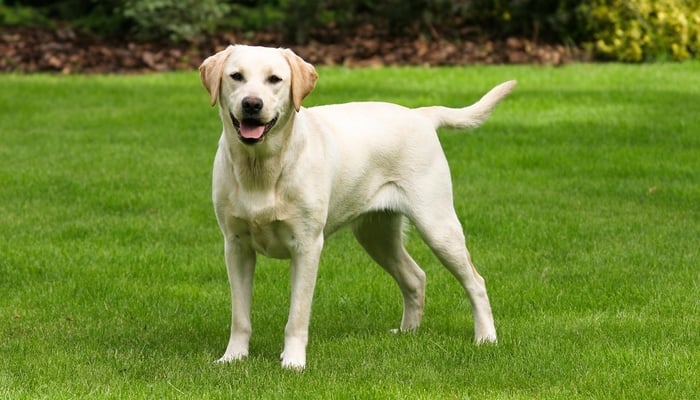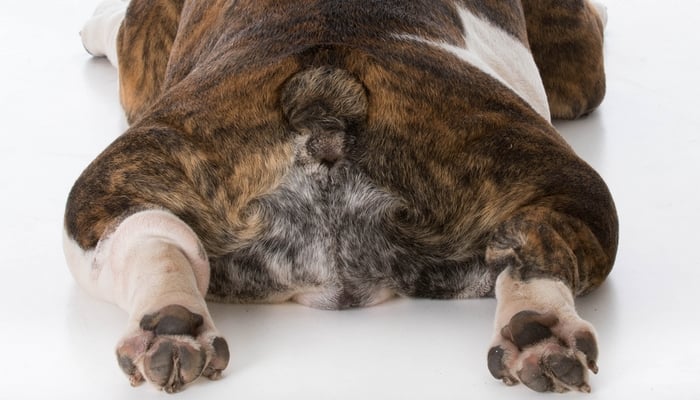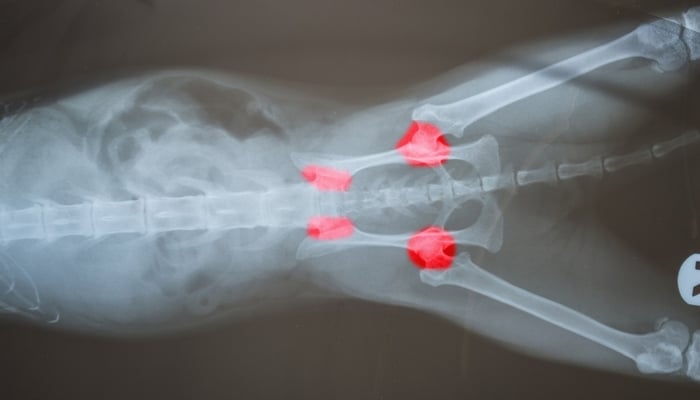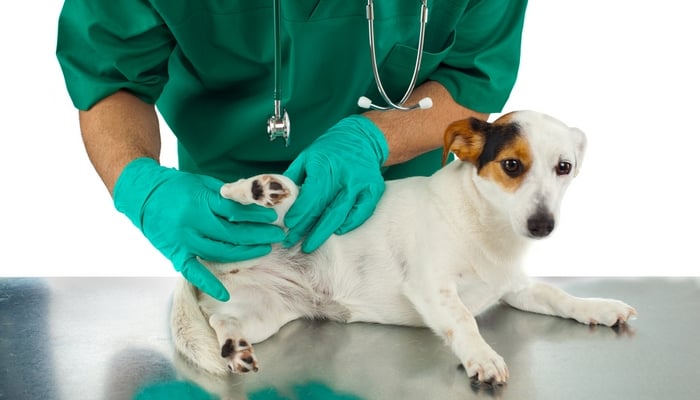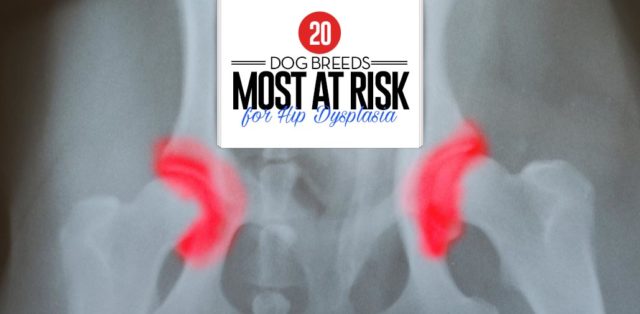
Disease of the dog’s hip joints is called hip dysplasia.
It occurs when one or both of dog's hips have a ball that does not fit tightly into its socket.
It can be because of a deformity in the joint, malformed muscles or damage to tendons and ligaments, and some dog breeds are more at risk of developing hip dysplasia than others.
While some observations have been made that this illness occurs more often in large breed dogs, that's not entirely clear; some medium size dogs are even more likely to develop hip dysplasia.
The worst recipe is a medium or large size dog with predisposition to this disease that is also overweight.
The age of the dog plays a huge part as well.
For example, a meta-review of scientific literature going back to 1980 have observed that Siberian Huskies have a 3-5% (lowest) chance of developing hip dysplasia, while Cane Corso dogs were at 59.7% and English Bulldogs were at 83% (highest) chance of developing the condition.
Golden Retrievers and Old English Sheepdogs are also at very high risk of hip dysplasia.
Further research into this found that as breeders are more aware of hip dysplasia and are working towards eliminating it, some breeds have had a significant decrease of hip dysplasia cases.
Bernese Mountain dogs, Rottweilers, Briards, White Swiss Sheepdogs, Gordon Setters and Berger Picards have a decreased chance compared to older cases.
This is a painful condition, and it usually gets worse as the dogs age.
Although it is a degenerative disease, there are ways to slow down the progression of hip dysplasia.
We will talk about those prevention methods in a bit.
First, I'll tell you about the 20 dog breeds that are most at risk for for this disease.
I don’t want to only focus on the negative “hip dysplasia” aspect, so you will also get a little information on each breed.
I'll also list the symptoms that you need to be on the lookout for and give you some tips to prevent hip dysplasia from setting in early.
ALSO READ: 25 Dog Breeds Most at Risk for Arthritis
20 Dog Breeds Most at Risk for Hip Dysplasia
1. Labrador Retriever
Pictured above, these easy to train dogs are smart and friendly. Labrador Retrievers are also very playful throughout their entire life span.
They make great pets for homes with kids and other dogs. These short hair canines do shed quite a bit. An adult Lab usually weighs about 60 – 80 pounds.
2. Saint Bernard
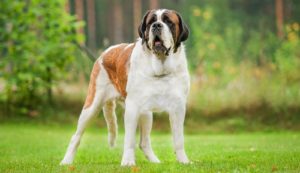 An affectionate breed, the Saint Bernard is great for homes with kids and other pets. They cannot tolerate the heat well, so they are best suited for colder climates.
An affectionate breed, the Saint Bernard is great for homes with kids and other pets. They cannot tolerate the heat well, so they are best suited for colder climates.
Saint Bernards are a tad lazy, and they don’t need a lot of exercise. These pups will grow to weigh around 130 – 180 pounds. Their large size is one of the leading factors that plays into the development of hip dysplasia at an early age.
3. Golden Retriever
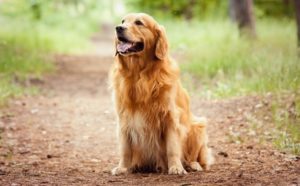 Often confused with Yellow Labradors, the Golden Retriever is actually a separate breed. One of the most popular breeds in America, these loving dogs are loyal and easy to train.
Often confused with Yellow Labradors, the Golden Retriever is actually a separate breed. One of the most popular breeds in America, these loving dogs are loyal and easy to train.
Energetic pooches, they are best suited for the active, outdoors family. At their prime, they will weigh around 55 – 75 pounds.
4. Rottweiler
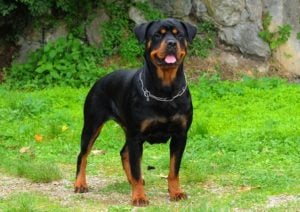 Rotties are calm and brave. They are not known to be hyper and pesky.
Rotties are calm and brave. They are not known to be hyper and pesky.
While the Rottweiler is friendly with its human family, they are not usually the same way with other pets.
These independent dogs need an experienced trainer. They will weigh from 90 – 130 pounds in adulthood.
5. German Shepard
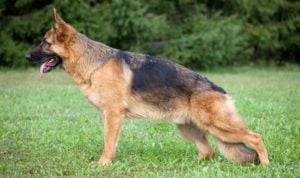 Hard working and focused are the two traits that most describe the German Shepherd. They are not overly friendly with strangers, so they are not easily distracted when training and going about their business.
Hard working and focused are the two traits that most describe the German Shepherd. They are not overly friendly with strangers, so they are not easily distracted when training and going about their business.
German Shepherds need to work with an experienced training or they may begin to exhibit bad behaviors. Once these pooches are full grown, they will weigh between 75 – 95 pounds.
6. Great Dane
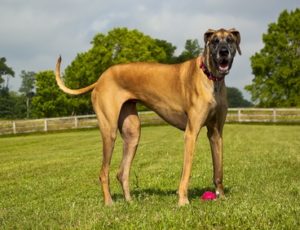 These gentle giants are loving and loyal. Danes make great pets for active families on the go. These canines have tons of energy and will need room to romp.
These gentle giants are loving and loyal. Danes make great pets for active families on the go. These canines have tons of energy and will need room to romp.
Potential owners should also keep in mind that everything is more expensive when you have to buy it bigger. Great Danes weigh 95 – 200 pounds when full grown.
7. Alaskan Malamute
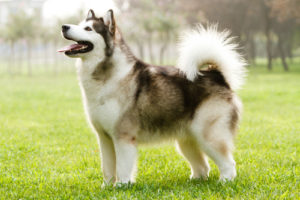 These double-coated canines do not do well in hot temperatures. They were made for the Artic, and that type climate is the one they are healthiest in.
These double-coated canines do not do well in hot temperatures. They were made for the Artic, and that type climate is the one they are healthiest in.
A great work dog and guard dog, Malamutes are reserved with strangers. These pups do love to dig, so be prepared! This breed weighs 70 – 105 pounds in adulthood.
8. Old English Sheepdog
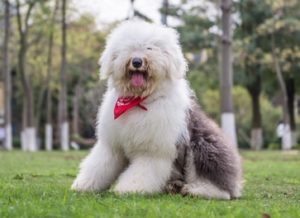 Adaptable and easy to train, the Old English Sheepdog is gentle and fun-loving. Also called “Bobtails”, this breed is another working breed.
Adaptable and easy to train, the Old English Sheepdog is gentle and fun-loving. Also called “Bobtails”, this breed is another working breed.
Great with other animals, kids, and strangers, this pup is great for country or city life. At full-grown, these dogs weigh between 60 – 100 pounds.
9. Mastiff
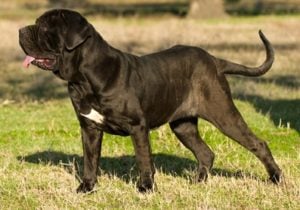 (Japanese Tosu Inu, Bull, Brazilian, Neapolitan, Argentino, etc.) An independent and strong willed breed, Mastiffs make great guard dogs.
(Japanese Tosu Inu, Bull, Brazilian, Neapolitan, Argentino, etc.) An independent and strong willed breed, Mastiffs make great guard dogs.
Needing a strong and experienced trainer, these gentle giants are still far removed from their war-loving ancestors. These canines will weigh 120 – 230 pounds.
RELATED: 4 Dog Breeds That Require the Most Care, Maintenance and Money
 10. Chesapeake Bay Retriever
10. Chesapeake Bay Retriever
Chessies are tough dogs. They are well adapted for the outdoors. While they are loving and friendly with their people, they do not get along well with other animals.
The Chesapeake is suspicious of strangers and make excellent watch dogs. 55 – 80 pounds is what you can expect for your fur-baby’s adult weight.
11. Catahoula Cur Dog
 Bred for working in the swamps, this dog can keep up with anything and anybody. So, if you are into hiking and hunting, this pooch may be for you.
Bred for working in the swamps, this dog can keep up with anything and anybody. So, if you are into hiking and hunting, this pooch may be for you.
They also have unusual looks that make a great conversation starter. The Catahoula Cur can weigh anywhere from 35 – 85 pounds.
12. Chow Chow
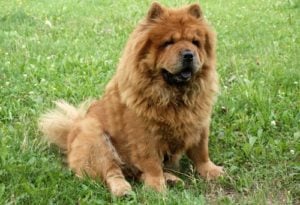 These regal dogs need a strong trainer who is well-versed in “pack leader” training. Known to be aggressive, care should be taken in households with kids and other pets.
These regal dogs need a strong trainer who is well-versed in “pack leader” training. Known to be aggressive, care should be taken in households with kids and other pets.
One thing this dog has going for it is that it is independent and does well with alone time. Chows will usually weigh 45 – 70 pounds.
13. Bloodhound
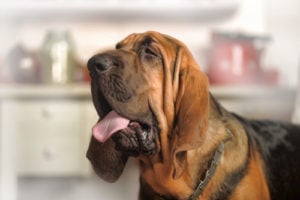 A symbol of search and rescue, the Bloodhound has great olfactory senses. Intelligent and affectionate, these canines are easy to train. A great family pet, this hound is friendly with everyone it meets.
A symbol of search and rescue, the Bloodhound has great olfactory senses. Intelligent and affectionate, these canines are easy to train. A great family pet, this hound is friendly with everyone it meets.
If you own one of these, make sure you have a fence. This pup loves to follow his nose. Their weight is 80 – 110 pounds.
14. Pug
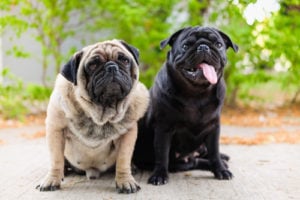 The Pug is a mischievous breed that provides hours of entertainment to its companions. Unfortunately, these affectionate dogs are not very healthy.
The Pug is a mischievous breed that provides hours of entertainment to its companions. Unfortunately, these affectionate dogs are not very healthy.
Their facial structure can cause breathing problems and over-heating. Even though they will only weigh 10 – 20 pounds, they are still known to suffer from Hip Dysplasia.
15. Bulldog
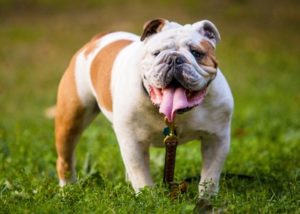 (French, American Pitt Bull Terrier, American Bulldog, Staffordshire Bull Terrier, etc.) At one time, the bull dogs were known as “nanny dogs” .
(French, American Pitt Bull Terrier, American Bulldog, Staffordshire Bull Terrier, etc.) At one time, the bull dogs were known as “nanny dogs” .
English Bulldogs are naturally great companions for children. Unfortunately, breeding and training for aggression has destroyed their reputation. They weigh 30 – 70 pounds.
16. Boxer
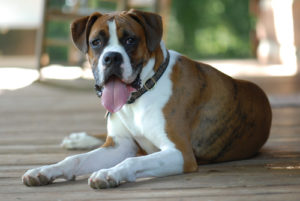 These dogs are imposing in stature with their long, lean muscles; however, they are really just bundles of furry love. These pups make great companions to adults, children and other animals.
These dogs are imposing in stature with their long, lean muscles; however, they are really just bundles of furry love. These pups make great companions to adults, children and other animals.
Dogs in this breed are usually very quiet. They don’t participate in nuisance barking. Your Boxer will weigh 55 – 75 pounds when he's full grown.
17. Newfoundland
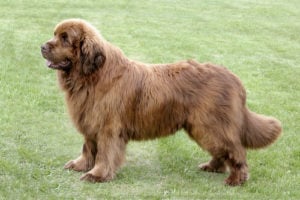 A great family dog, these loving animals are very friendly. If the house is often empty, this is not the pet for you. Newfoundlands do not do well when left alone.
A great family dog, these loving animals are very friendly. If the house is often empty, this is not the pet for you. Newfoundlands do not do well when left alone.
Patient and kind, these pups actually prefer the company of children. These canines will usually grow to weigh from 95 – 150 pounds.
18. Basset Hound
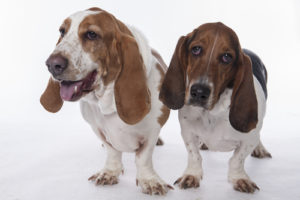 Calm and low key, the Basset Hound loves to just lie around and take it easy. These lazy dogs are great for first time owners, and ones who are lazy trainers.
Calm and low key, the Basset Hound loves to just lie around and take it easy. These lazy dogs are great for first time owners, and ones who are lazy trainers.
Extremely friendly, you will never have to worry about aggressiveness in this pooch. While short-legged, adult dogs will weigh between 45 – 70 pounds.
19. Standard Poodle
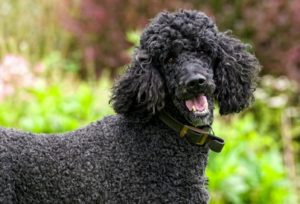 These dogs are affectionate and adaptable. Poodles are easy to train and can live happily in many situations, such as apartments, no yard, with big families, with other pets, etc.
These dogs are affectionate and adaptable. Poodles are easy to train and can live happily in many situations, such as apartments, no yard, with big families, with other pets, etc.
A “hypo-allergenic” dog, dogs in this breed shed very little. A medium size breed, these fur-babies can weigh 20 – 60 pounds.
20. Otterhound
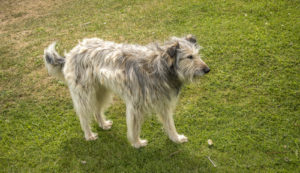 These personable dogs are friendly and affectionate, but they are also good at entertaining themselves. In fact, they are one of the best breeds for spending time alone.
These personable dogs are friendly and affectionate, but they are also good at entertaining themselves. In fact, they are one of the best breeds for spending time alone.
Otterhounds will love attention and play, but they are not clingy and needy. Canines in this breed will weigh 60 – 110 pounds.
SIMILAR: 20 Most Friendly Dog Breeds in the World
Symptoms of Hip Dysplasia in Dogs
Now that we have highlighted the breeds most at risk for hip dysplasia, let’s look at the symptoms.
The most common symptoms of dog hip dysplasia include:
- Wobbling when rising from a seated position
- Falling over when urinating or defecating
- Reluctance or refusal to climb stairs
- Shortened stride when walking
- Decreased activity
- Narrowing of gap between hind legs
- Loss of muscle mass in thighs
- Hopping from crouched position to move (bunny hopping)
Prevention of Hip Dysplasia in Dogs
There are several ways to prevent hip dysplasia or slow down its symptoms.
While size is one of the main factors in the development of the disease, a genetic component is also present.
For this reason, you should never purchase a puppy whose parents suffer from hip dysplasia.
Other preventative measures include:
- Weight plays a big part in joint deterioration. To make sure this isn’t going to be an issue for your pup, you need to take steps to make sure your dog is always at a healthy weight.
- Appropriate exercise
- No table scraps
- Measure food for perfect portions
- Choose healthy treats and moderate snacking
Supplements and vitamins for dogs can also improve your pet's joint health. Make sure you check with your vet before adding any supplements to your fur-baby’s daily routine.
Some of the most highly recommended supplements for dogs with hip dysplasia include:
- Glucosamine is a natural chemical already present in the body of many animals. It keeps the cartilage healthy.
- Chondroitin is another molecule that is already present in you and your pup’s body, this also helps keep the cartilage healthy.
- Fish oil for dogs which is full of Omega 3 Fatty Acids that are found in fish, seaweed, sunflowers, soybeans, flax seeds and more. This miracle substance inhibits the expression of proteins that harm the joints.
- Antioxidants work by preventing the production of pesky “free radicals” that can damage joints. Antioxidants are prescribed for canines who are prone to joint damage.
Puppies that are in the large breed category need extra care in their growing years.
If you follow a few simple rules during this time, your pup will have a greater chance to grow up healthy and strong.
- No Frisbee and other jumping activities, especially in the first year
- Swimming is great, but do not encourage jumping into the pool
- When your puppy is ready to stop playing or training, stop – don’t push it
- If possible, avoid stair climbing with your pooch
RECOMMENDED: Top 5 Best Dog Arthritis Supplements
Treatment of Hip Dysplasia in Dogs
So, you have done everything you could to prevent having a furry family member with hip dysplasia, but it still happened to your dog. What now? Don’t panic!
There are many treatments that your vet can provide as well as at home remedies that will improve the outlook and quality of life for your canine. There are many things you can do at home that will help your dog be more comfortable.
Just changing some aspects of your pup’s daily routine will make a world of difference to your suffering dog. Elevate the food and water bowls so your pet doesn’t have to stoop to eat and drink. There's some evidence that it can alleviate the pain.
Provide an orthopedic dog bed for your canine to sleep on. Orthopedic dog beds support your dog's weight and prevent the hip and joint problems from developing further, and in some cases alleviate the pain from current condition.
If your fur-baby still enjoys walks, use a support dog harness for comfort. You can also buy a rear leg sling if needed, or make one yourself (here's a DIY guide for it).
Install a dog ramp wherever possible so your dog doesn’t have to climb stairs or jump up. Pet ramps can be found for beds, cars, and stairs. Don’t exercise your dog first thing in the morning. Allow him to warm up at his own pace. Here's how to teach your dog to use pet ramps (video) and to prevent further complications.
You can also try pet stairs for dogs, although they may not be ideal for dogs with hip dysplasia or arthritis, but here's how to choose the best ones.
Once your vet diagnoses your pet with hip dysplasia or the disease progresses to the point of causing significant symptoms, there are medications that can help your canine find relief. Of course, you'll need to speak with your vet before starting Fido on any medications.
Non-Steroidal Anti-Inflammatory Drugs (NSAIDs) – These are drugs like ibuprofen. They reduce inflammation and relieve pain.
Opioid Pain Medication – Drugs in this category can be made from the poppy plant or from synthetic materials. They can relieve pain only.
Steroids – Medications in this class work with your immune system to reduce inflammation and decrease pain.
READ: Science-based Canine Athlete Nutrition – How to Feed Athletic Dogs?
Surgeries for Dogs with Hip Dysplasia
There are also several surgeries that can be performed to improve your furry family member’s health when it comes to hip dysplasia. Surprisingly, they are the same surgeries that are performed on humans with hip joint problems.
- Total Hip Replacement (THR) – In this surgery, the ball and socket are replaced with synthetic material.
- Dorsal Acetabular Rim Arthroplasty (DARthroplasty) – The hip socket is deepened by grafting bone from other sites to the rim of the socket.
- Triple Pelvic Osteotomy (TPO) – This repositions the hip socket for a tighter fit.
- Femoral Head Osteotomy (FHO) – The head of the femur is removed to prevent pain.
Some of these treatments may seem extreme, and they are (they are also costly). They are not used unless someone has the money and the time for the physical rehabilitation that comes after the procedure.
That is why prevention is always the best way to go when it comes to hip dysplasia in dogs. The important thing to remember is that you are doing the best you can do to keep your fur-baby comfortable, and that is enough.
Related Articles:
- 30 Healthiest Dog Breeds That Live the Longest
- Hip Dysplasia in Dogs: Signs and Treatments
- Recipe: Homemade Dog Food for Joint and Hip Health
Want to share?


